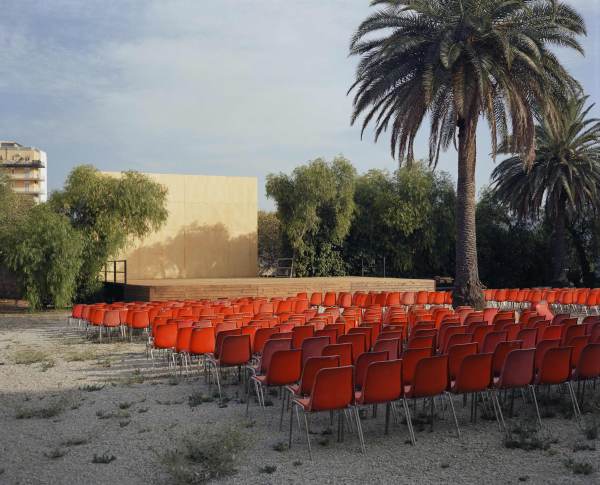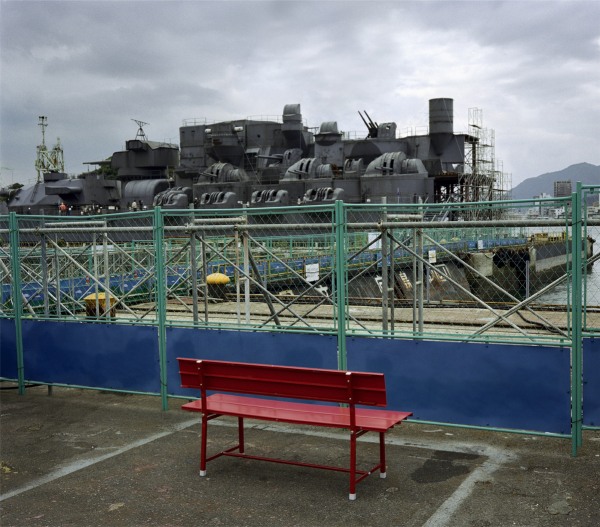Via dpr-barcelona
-----

The relationship between architecture and photography is so old as both disciplines. While Anne Elisabeth Toft asks “Is it possible to capture, translate and transmit architectural experience via representations?” we can recall to the most recent work of the filmmaker and artist Wim Wenders, called Places, strange and quiet which is based on a fascinating series of large-scale photographs taken in countries around the world from Salvador, Brazil; Palermo, Italy; Onomichi, Japan to Berlin, Germany; Brisbane, Australia, Armenia and the United States. Wenders pointed on his latest publication:
When you travel a lot, and when you love to just wander around and get lost, you can end up in the strangest spots. I have a huge attraction to places. Already when I look at a map, the names of mountains, villages, rivers, lakes or landscape formations excite me, as long as I don’t know them and have never been there … I seem to have sharpened my sense of place for things that are out of place. Everybody turns right, because that’s where it’s interesting, I turn left where there is nothing! And sure enough, I soon stand in front of my sort of place. I don’t know, it must be some sort of inbuilt radar that often directs me to places that are strangely quiet, or quietly strange.
But what about photographing not buildings, but landscape, urban voids and ruins? Can we talk about the same relationship as in between architecture and photography?


Most of Wim Wenders‘ photographs are created during his personal travels and while location-scouting for his films. From his iconic images of exteriors and buildings to his panoramic depictions of towns and landscapes, it’s not strange to find some of his movies accompanied by photo exhibitions and publications such as The Heart is a Sleeping Beauty as part of The Million Dollar Hotel or his 1999 film Buena Vista Social Club which was featured with the companion book by Wim Wenders and Donata Wenders.
Wim Wenders was a painter before he started working on film and photography, and he talked about this in an interview with Michael Coles:
I was heavily influenced by the so-called New American Underground. A lot of American painters made movies in the mid to late ’60s, Warhol being the most famous one. There was a whole retrospective traveling through Europe at the time. I saw these films in ’66 or ’67, and that was very important for me. I wrote about them, too. I wrote about Michael Snow especially, and a film that he had made called Wavelength (1967). It was the first article I wrote. Wavelength was a painter’s film. It was actually only one shot, a painstakingly slow zoom across a room toward the windows. Day and night were passing. Nothing much happened. It was very painterly. My first films were basically landscape paintings, except that they were shot with a movie camera. I never moved the frame. Nothing ever happened in them. Each scene lasted as long as a 16-millimeter daylight reel, which was about four minutes. There was no editing involved, other than attaching one reel to the other.
Wenders photographic work is obviously very cinematic. His approach to catch the right moment and the right place, his sensibility to transmit with images what a urban place can mean and the way he freezes different urban context is widely poetic and full of literary references.

Wenders points that he doesn’t think that any photographer has anything else in mind than that particular moment he is capturing. This is the main guideline of the photo-work of the exhibition that will take place at the Haunch of Venison, in London.
“…but a story,
from that story came a script,
and from the script a film -
which never wanted to conceal
that it might just as well have become a song:
a song about a different America
beyond that great big Dream,
where truly
everyone
is
equal.”
- Wim Wenders


As he said, “discovering the story that a place wants to tell. That’s my main concern, my attitude. Listening to the place. For me, taking a picture is more an act of listening, so to speak, than of seeing.” Now, the questions hidden in every picture are always the same:
What happened to that place? What happened to those people? How does this house or this street or this landscape look now, 10 or 30 years later?
—–
Image credits:
[1] Ferris Wheel, Armenia 2008, C-Print, 151,3 x 348 cm © Wenders Images GbR
[2] Open Air Screen, Palermo 2007, C-Print, 186×213 cm © Wenders Images GbR
[3] The Red Bench, Onomichi, 2005, C-Print, 186 x 200,6 cm © Wenders Images GbR
[4] Cemetery in the City, Tokyo 2008, C-Print, 132×133 cm © Wenders Images GbR
[5] Moscow Backyard, Moskau 2006, C-Print, 125×139 cm © Wenders Images GbR
[6] Ferris Wheel (Reverse Angle), Armenia 2008, C-Print, 151,3 x 348 cm © Wenders Images GbR
The book Places, strange and quiet has been published by Hatje Cantz Verlag. More info at their web-site






